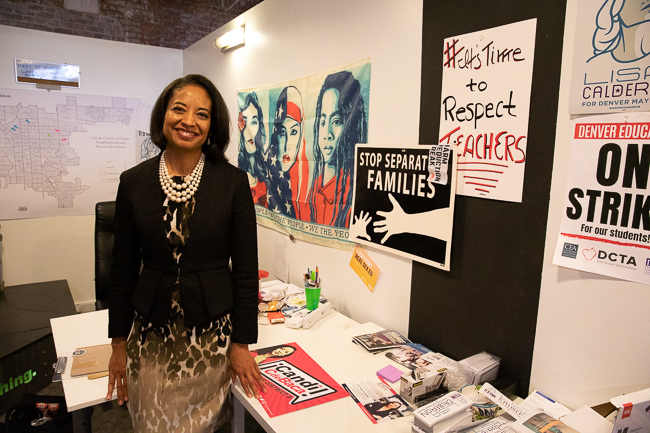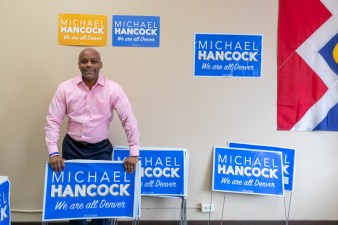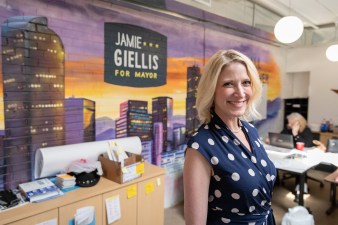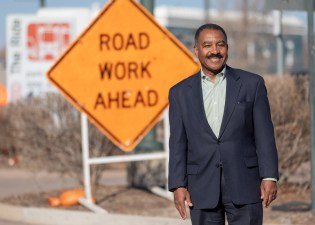Mayoral Candidate Dr. Lisa Calderón: The Streetsblog Interview

This is the third of a series of interviews with four candidates for Denver mayor in the May 7, 2019 municipal election. Editor Andy Bosselman conducted and condensed each interview. Several members of the Streetsblog Denver board of directors advised Bosselman in choosing the candidates and the subject matter covered. Other interviews include: Sen. Penfield Tate, Jamie Giellis, Mayor Michael Hancock and Kalyn Heffernan.
Dr. Lisa Calderón is a full-time faculty member at Regis University where she teaches sociology, criminal justice and urban planning.
Q: Briefly, what can you do for Denver that Mayor Hancock can’t?
A: There’s so much. I come from an equity lens first, in terms of who’s been left out. Pick your issue: affordable housing, transit.
Initially [I would] have one integrated plan for Denver, which we don’t currently have.
The other, because I am an academic and a researcher, I want to make sure that we have outcome measures, and that we’re using accurate data.
I would also separate the [Community Planning and Development Department] into two separate entities. Right now, what we have is [a] development office that is driving the planning, as opposed to the other way around.
Part of my resident-led platform is having plans, and the future visions for our neighborhoods, to actually come from the neighborhoods. Rather than having the top-down, City Hall pushing their ideas onto us, we [would] actually have those planners in the neighborhoods.
In a nutshell, it’s residents first, what residents want and need. How do we make it accessible and affordable for everybody? And at the same time, how do we make sure that we are speeding toward sustainable Denver, which has not been a priority for this mayor.
Q: I don’t know if you’re familiar with Janette Sadik-Khan [Streetsblog interview], she helped New York transform its streets and mobility options under Bloomberg. When it comes to adding walking, biking and transit infrastructure, a lot of that requires taking out parking. When the New York press was calling for her head — multiple times through her tenure — Mayor Bloomberg stuck by her. Even though residents were initially very unhappy, since those changes have been put in place, residents have actually started begging for those improvements. But they needed that initial leadership around things that were not popular. When you’re putting the community first in those discussions, how do you lead them to things that may be initially unpopular?
A: When you’re going to change behavior it needs to be incentive-based, not just a punishment or an imposition. Even if it’s a great idea — and even if we know we need to change, even it’s in our best interest — we won’t if somebody tells us to do it. That’s why we have to show that it’s actually a benefit to them, rather than an imposition. When the benefits outweigh the costs is when we start seeing more voluntary behavior change.
What I’ve been hearing from people who resist the idea of less spaces for cars and making a more people-centric city is: What’s the alternative? Right now they can’t see the alternative. What we see is, we can’t get around the city very easily. And so if you take away my car, that’s going to make it even worse.
And what we’re saying is that it’s actually going to be a benefit that you don’t have to use your car. Or it’s actually going to even be more equitable for those who don’t have a car … so that everybody can get around equally regardless of their zip code their background. That’s a plus for everybody. So let’s talk about, in your neighborhood, how do we make that happen?
Q: What’s your vision for Denver’s transportation future?
A: Essentially that it’s affordable, reliable and accessible for everyone. That it’s also sustainable in terms of net-zero carbon emissions.
I’m a supporter of the Green New Deal. It may not be perfect, it doesn’t have all of the details yet, but [I support] the sense of urgency, that we have to do something to protect our climate.
I raised a son who has chronic asthma. I know what that means as a parent, to rush your child to the emergency room.
And as a bicyclist, the fact that I have to hold my breath sometimes just going past [the Suncor refinery] … I don’t want us to have to monitor the times that I go outside. [Like when she was in Beijing.]
I want to prioritize our funding sources so that we could get to that affordable, accessible and reliable transportation system that’s going to be good for the environment.
Q: Tell me about the last time you took public transportation.
A: It was a Michelle Obama event [last year]. We took the light rail.
When I’m traveling, I love it. I love using other cities’ transportation systems. It’s a pain in the ass in Denver.
I used it for my first 21 years of my life. In fact, I didn’t have a driver’s license until I was 21. Being a single mom on public assistance, I couldn’t afford a car. I went everywhere with my baby, and my groceries, and my stroller. That’s what it took.
We grew up with RTD. And also, as a woman, it’s not always the best option sometimes to ride, so we have to deal with that as well.
Q: You have said that you support the city’s Vision Zero goal to end all traffic fatalities and serious injuries by 2030. According to the Denver Streets Partnership, making the needed bike and pedestrian changes would take 100 years to achieve at current funding levels of about $5 million per year. Roughly $40 million per year is needed to meet the goal by 2030. How would you come up with that amount of money?
A: We need to look at a couple of things, that as you pointed out may not be popular initially, but are for long term investment. A road usage fee would be one of those things, looking at the mileage that you’re using.
Q: Could that be implemented at the city level?
A: That’s what we need to look at. What would it look like if we were going from here to D.I.A., versus using the train?
[She mentioned distance- or zone-based public transit fares that increase depending on the distance you travel.] That concept isn’t totally foreign to folks, especially those using public transportation.
I think where [user fees for roads have gotten a] bad rap is that it’s benefited those [who build and use toll roads, or…] “Lexus lanes,” as opposed to if it’s for everybody.
We’re also assessing fees for high times of high ozone … because what we’re trying to do is reduce the pollution for everybody. That means everybody needs to help with that. So not just for congested areas, to dissuade cars coming into the central business district, but also in high ozone times.
Q: If you look at the region’s gleaming light rail system, which serves mostly white, suburban commuters going to downtown jobs, and compare that to the slow, unreliable bus service and really, truly sad bus stops that tend to serve economically and racially diverse communities, it’s clear that the region has invested much more in office workers than other transit riders. You told Westword that you would hold the Regional Transportation District “accountable to be more affordable and inclusive of all communities.” How would you do that?
A: First, using the leverage and the influence of the mayor’s office to say that prioritizing sustainability means that we give people transit options so that they aren’t being car dependent.
Our transportation options are often geared toward those who can afford it. The professional class, as opposed to those who need to get off and on again. Like when I was a parent, I needed to get to the grocery store.
[We should] have regularly running transit, that people can get off and on, they don’t have to wait longer than five or ten minutes. That’s why I’m a proponent of smart growth strategies, because it’s built around walkable, bikable — everything you need within your neighborhood — but that also means reliable transit.
Q: The city has a goal to reduce the number people driving alone in cars from 73 percent of all trips today to 50 percent by 2030. The Denveright plans call for creating a network of high-frequency transit. Some candidates have suggested that Denver should create its own transit agency, which would compete with RTD. Others say Denver should follow cities like Seattle and Boulder, which pay the regional transit operator to provide more service in the city. Do you support a high-frequency network, and if so, do you have a preference for how it is achieved?
A: I do support it, but I’m not quite sure which preference. I’d have to study each of those systems more. I do like the idea of us taking more control of our transit system instead of the excuses, “It’s RTD, we have no real authority over them.”
They’re using our streets. Our roads. Our people’s money. We should have much more leverage and say about the routes, and the vehicles, that are used, et. cetera.
Q: Either way, to provide transit service that’s good enough to attract drivers to buses and trains, a lot of money is needed. The mayor’s plans are estimated to cost $2 billion, another candidate suggested $5 billion. Like Vision Zero, that’s a lot of money. How much do you think is needed, and where would you find it?
A: When I said the mayor is so in the 80s when it comes to the ten lane [highway] expansion, we could be instead investing into more boulevards, greenscaping.
So five billion for our roads [and transit]. And about 2 billion for our bike paths and walkways, other connectors.
Q: Public transit works best when it’s near dense neighborhoods. What would you do to encourage more transit-oriented development? And would you support high-rise residential buildings in neighborhoods outside of downtown?
A: I’m not afraid of density. When you go to the other major world-class cities, especially those that do it better, you see that it actually works well.
The concern that communities have is they don’t feel that they have a voice in how that density is going to look.
I’m in favor of smart density, from that smart growth strategy. For example, those small businesses on the first level, having a major grocery store on the second level, and then you have mixed-income housing up above. That way you can get everything you basically want within your neighborhood, or within your immediate radius.
When it comes to higher buildings, I think it depends on what those high buildings are for. Are they geared for fostering community?
This is where I want to go with returning to the village concept, where we have more social interaction with each other. Because you can also have sprawl that’s tall, as you do with it being wide. Both of those have aspects of this dissociation from your neighbors. And so I would say: What are those tall towers looking like? And who are they for?
Q: I wanted to ask you about that because you have said that you want every development to include affordable housing. Considering the high cost-per-square-foot of many market-rate housing projects, especially high-rises, developers often prefer to pay municipalities so that they can build affordable housing elsewhere. That also allows cities to get more bang for their buck. Tell me about your position on this.
A: I don’t think developers should use linkage fees to get out of affordable housing units. [The city should be] negotiating affordable housing at the front end, rather than at the back end, which is what the city does now.
The Elitch development: We still don’t know what the developer is committing to. Out of, I think 15,000 units, 700 to 1,000 are going to be affordable. What does that look like? Affordable for who?
No, the priority is the units and not the fees.
Q: You have suggested creating a Housing Department that would use participant-public-private partnerships, or P4, to guide future development. I’m not familiar with P4. How does that differ from current practices and what benefit would it have?
A: The current practices are: The mayor allotted five million [dollars] for the public-private partnership office. That wasn’t done with community input. That wasn’t done with any sort of mechanism for oversight.
When we put the participant or the community added to it, that means the community is also at the table.
Rather than it being an insider-baseball planning process, between the city and the corporate interests, we’re saying the communities who are most affected … need to have a seat at the table.
Streetsblog Denver informs the movement for sustainable transportation and a livable city. Give $5 per month.




